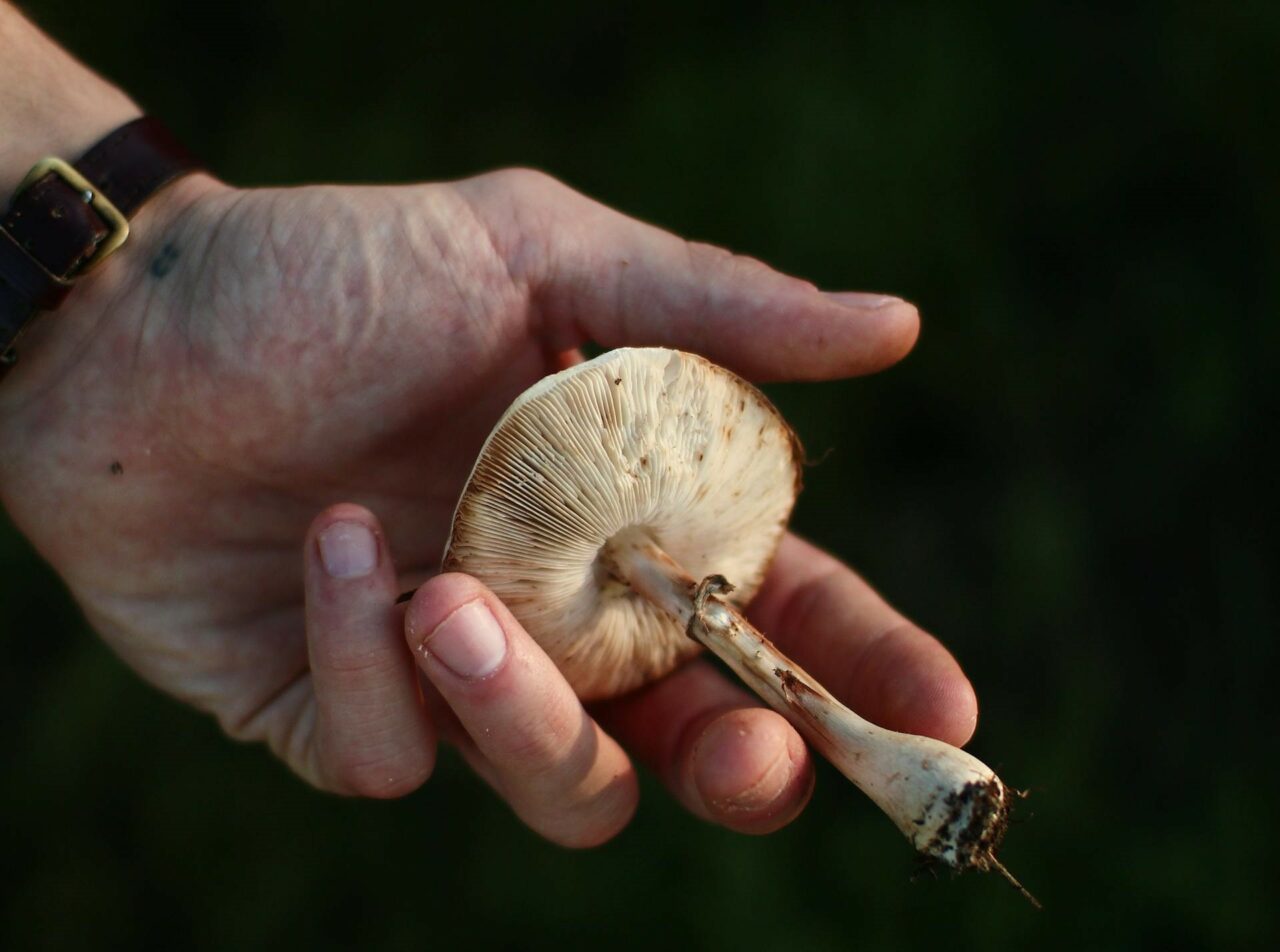Psilocybin mushrooms, a traditional psychedelic, operate similarly to LSD as a serotonin 5-HT2A receptor agonist. Their potential therapeutic applications for mental health disorders are currently under investigation. These disorders include major depression, anxiety, cluster headaches, and emotional distress associated with migraines.
Understanding how shrooms can alleviate these conditions necessitates a deep dive into how they metabolize in the body. Gaining such knowledge enables both researchers and users to comprehend how the active compound triggers psychological and therapeutic effects. This article offers a basic guide to the pharmacology and pharmacokinetics of psilocybin.
[toc]
Key Takeaways:
- About half of the consumed psychedelic fungi is absorbed and distributed throughout the body when taken orally.
- The compound in the fungi undergoes dephosphorylation by the enzyme alkaline phosphatase, primarily in the liver.
- Approximately 3.4% of the compound is expelled in its original form within a day, with the majority being discharged as a stable metabolite.
What is Pharmacokinetics?
Pharmacokinetics (PK) is a field that studies how substances like drugs are processed by the body once they’re ingested. It’s a separate but related study to pharmacodynamics, which focuses on how a compound interacts with the body. PK investigates four main areas: absorption, distribution, metabolism, and excretion (ADME).
Grasping these processes equips healthcare providers to prescribe the most effective medications with the least amount of risk. It also allows them to customize treatments to suit each patient’s unique physiological needs and lifestyle.
How Does Pharmacokinetics Relate to Psilocybin?
Psilocybin and psilocin, the primary active compounds in certain types of magic mushrooms, have piqued significant interest among researchers and users alike. Pharmacokinetics investigates how the body processes mushrooms containing psilocybin, thereby helping to comprehend their potential effects, be they medicinal or recreational.
These compounds go by various names, such as “magic,” “psychedelic,” “medicinal,” or “sacred.” The fungi containing these compounds are consumed, with The varieties of mushrooms, their geographical origin, size, the conditions in which they flourish and are dried, and their age can all lead to considerable variations in their potency.
These mushrooms naturally exist in the wild, but scientific processes have been developed to artificially create them in a lab. Both the naturally occurring and synthetic forms have a low level of toxicity, although minor side effects such as nausea or vomiting may sometimes occur.
Despite these minor physical effects, the compounds within these mushrooms have been found to potentially possess therapeutic benefits due to their safe profile and non-addictive characteristics. These findings have sparked interest within the research community, leading to investigations into their use in psychotherapy, particularly as a potential treatment for anxiety and depression.
The 4 Phases of Pharmacokinetics
Psilocybin, the compound present in these mushrooms, is inactive in its natural state, functioning as a prodrug that transforms into its active form, psilocin. Enzymes such as alkaline phosphatase facilitate this conversion, enabling psilocin to be absorbed and circulated throughout the body, reaching various tissues. However, after being orally administered, psilocybin cannot be detected in the circulatory system, feces, or urine.
Absorption
Absorption is the process by which the compound moves from the administration site into the bloodstream. This process significantly influences the speed and effectiveness at which the compound reaches its target, such as the plasma. Oral administration is the most commonly used method. Inhalation has been tested, but has not proven to be as effective as ingestion.
The absorption process also includes the release of the compound from the dosage form during oral intake. Factors like delays in the throat or esophagus may affect this, possibly slowing down the results or leading to irritation. Once the compound arrives in the stomach, the acidic environment may start to decompose it before it can enter the bloodstream.
Studies in animals suggest that only around 50% of orally taken psychedelics are absorbed and distributed throughout the body.
Factors Affecting the Absorption Process
A number of factors can influence the absorption process, leading to variations in the onset, intensity, and duration of the effects:
- Stomach Contents: Consuming the compound on a full stomach can slow down the process by delaying the onset of effects. On the contrary, having an empty stomach can facilitate quicker absorption.
- Body Fat: The potential for substances to accumulate in fat tissues can potentially prolong their effects.
- Age: Metabolic rates and body composition typically vary with age.
- Zero-Order Kinetics: The substance is eliminated at a steady rate, regardless of its concentration.
- First-Order Kinetics: Elimination rate is directly proportional to the drug’s concentration.
The term ‘distribution’ is used to describe how psilocin spreads throughout the body once it enters the bloodstream. Due to its lipophilic nature, psilocin can penetrate the blood-brain barrier and access the central nervous system.
system.This process is influenced by several factors, including the size, polarity, and protein-binding capacity of the substance, as well as individual physiological characteristics such as hydration status and body composition.
The goal is achieving an effective concentration at the target site. For the substance to be effective, it must reach the desired area (as defined by the volume of distribution) and remain unbound to proteins, thus being able to interact actively with its receptor.
What Factors Affect the Distribution?
Several factors can influence the distribution process:
Generally, the effects start to manifest around 20-40 minutes after ingestion, peak at about 80-100 minutes, and last for 4-6 hours when it comes to magic mushrooms.
How is the Brain Receiving the Substance?
An early experimental study on two species showed that the order of binding affinity is 5HT2A > 5HT1A > 5HT2B [23]. It also binds to dopamine D1, 5HT1E, 5HT5A, 5HT7, 5HT6, D3, 5HT2C, and 5HT1B receptors.
Psilocin acts as a partial agonist at the 5HT2A receptor, with an efficacy of about 40%. Its psychedelic effects can be linked to its partial agonist activity at 5HT1A autoreceptors.
The enhancement of mood and psychotomimetic experiences may be related to the correlation observed between increased dopamine levels and sensations of depersonalization and euphoria. Hallucinogens work by modifying neurochemical balance and receptor activity. They enhance 5HT2A agonist activity by increasing BDNF synthesis in the hippocampus, which promotes neurogenesis and reduces conditioned fear-related behaviors.
Elimination
Elimination refers to the process by which the The human body has several ways of eliminating substances, primarily through the kidneys, but also through the lungs, skin, or gastrointestinal tract. In the case of kidneys, they filter or secrete naturally occurring psychedelic drugs in the glomerulus or tubules, with aspects of reabsorption adding a layer of complexity to this process.
The primary compound has an average half-life of about 160 minutes, while psilocin has a half-life of roughly 50 minutes. Animal studies reveal that the majority of this substance is excreted through urine, making up about 65% within 8 hours of consumption. Small amounts of the substance can also be detected in bile and feces.
In humans, about 3.4% of the substance is expelled in its original form within a day, while the majority is eliminated as psilocin-O-glucuronide, a more stable metabolite. This metabolite’s stability allows the compound to be traceable in urine samples for a prolonged period.
Substance excretion primarily occurs through two methods:
Most psychedelic substances follow the first-order kinetics method, reaching constant concentrations after about four to five half-lives. Complete elimination typically occurs after four to five half-lives as well.
Discover Our Range of Hallucinogenic Mushrooms
The metabolic process differs among various types of fungi. Purchasing from reliable online vendors like Magic Mushies Canada helps you avoid inadvertently consuming poisonous mushrooms. Certain types, such as Agaric mushrooms, can cause intense and potentially unpleasant effects. Hence, it’s vital to acquire magic mushrooms from trustworthy sources, rather than from precarious street vendors or through wild foraging.
| Feature | Enigma | Full Moon Party | Gold Member | |
| Strain Type | Psilocybe Cubensis OMNI | Psilocybe cubensis (Thai Koh Samui) | Psilocybe cubensis | |
| Potency | Exceptionally high; 3.8% tryptamine content | Medium to high potency | High potency | |
| Visual Characteristics | Looks like a blob or | Resembles a cauliflower or brain structure | Has a traditional cubensis aesthetic; of moderate size | Features thick white stems and golden caramel caps, with distinct blue bruising |
| Effects | Recognized as the most potent, producing intense effects | Induces a strong mental high, with visuals emerging after a delayed onset | Generates powerful visuals and euphoria |
Explore Psilocybin Mushroom Usage Online
For medical professionals, researchers, and users, understanding the pharmacokinetics of shrooms is crucial. This knowledge aids in making informed decisions about dosage and timing, thus reducing potential risks.
Discover your perfect psychedelic experience at Magic Mushies Canada. Whether you desire a soothing journey or deeper exploration, our extensive product collection is designed to meet your unique needs. Enjoy the best, safe, and quality-assured shrooms, eliminating worries about dubious sources or poisonous mushrooms.
Indulge in the best magic mushrooms Canada has to offer and elevate your psychedelic adventure to unparalleled heights.
Frequently Asked Questions
Are there any known interactions between shrooms and other medications?
Our products may interact with certain medications, particularly those affecting serotonin levels, like SSRIs (Selective Serotonin Reuptake Inhibitors). SSRIs and SNRIs (Serotonin and Norepinephrine Reuptake Inhibitors) tend to lessen the effects, unlike non-serotonergic antidepressants. This reduced effect can last for up to three months after discontinuing antidepressant use.
Do all psychedelics follow the same pathway as psilocybin?
No, each psychedelic substance has a unique structure that requires different metabolic processes to activate, and they bind to various receptors in the body. The method of administration also affects the absorption of each psychedelic. Although the basic principles of absorption, metabolism, and distribution are the same, the specific pathways and effects vary for each substance.
Can the form of the shroom affect the pharmacokinetics?
Yes, the form (whether fresh, powdered, or dried mushrooms) can influence the absorption rate. For example, powdered forms may be absorbed faster than whole dried ones due to quicker dissolution.
Suggested Reads:





